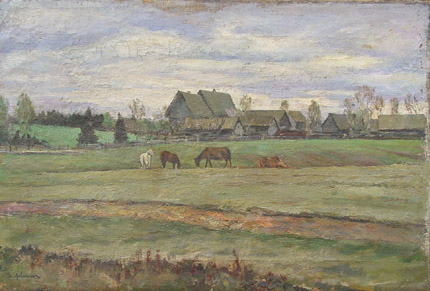 home
about
artists
exhibitions press
contact
purchase
home
about
artists
exhibitions press
contact
purchase |
|
|
|
ISAAC LEVITAN (1860-1900) Isaac Ilyich Levitan (August 30, 1860 – August 4, 1900) was a classical Lithuanian-Russian landscape painter who advanced the genre of the "mood landscape". Isaac Levitan was born in a shtetl of Wirballen, Province of Kowno in Lithuania (then in the Russian Empire) into a poor but educated Jewish family. His father Elyashiv Levitan was the son of a rabbi, completed a Yeshiva and was self-educated. He taught German and French in Kowno and later worked as a translator at a railway bridge construction for a French building company. At the beginning of 1870 the Levitan family moved to Moscow. In September 1873, Isaac Levitan entered the Moscow School of Painting, Sculpture and Architecture where his older brother Avel had already studied for two years. After a year in the copying class Isaac transferred into a naturalistic class, and soon thereafter into a landscape class. Levitan's teachers were the famous Alexei Savrasov, Vasily Perov and Vasily Polenov. In 1875, his mother died, and his father fell seriously ill and became unable to support four children; he died in 1877. The family slipped into abject poverty. As patronage for Levitan's talent and achievements, his Jewish origins and to keep him in the school, he was given a scholarship. Levitan's work was a profound response to the lyrical charm of the Russian landscape. Levitan did not paint urban landscapes; with the exception of the View of Simonov Monastery (whereabouts unknown), mentioned by Nesterov, the city of Moscow appears only in the painting Illumination of the Kremlin. During the late 1870s he often worked in the vicinity of Moscow, and created the special variant of the "landscape of mood", in which the shape and condition of nature are spiritualized, and become carriers of conditions of the human soul (Autumn day. Sokolniki, 1879). During work in Ostankino, he painted fragments of the mansion’s house and park, but he was most fond of poetic places in the forest or modest countryside. Characteristic of his work is a hushed and nearly melancholic reverie amidst pastoral landscapes largely devoid of human presence. Though his late work displayed familiarity with Impressionism, his palette was generally muted, and his tendencies were more naturalistic and poetic than optical or scientific. Levitan spent the last year of his life at Chekhov’s home in Crimea. In spite of the effects of a terminal illness, his last works are increasingly filled with light. They reflect tranquillity and the eternal beauty of Russian nature. He was buried in Dorogomilovo Jewish cemetery. In April 1941 Levitan's remains were moved to the Novodevichy Cemetery, next to Chekhov's necropolis. Levitan did not have a family or children. Isaac Levitan's hugely influential art heritage consists of more than a thousand paintings, among them watercolours, pastels, graphics, and illustrations. From Wikipedia |
|
|
E-mail: info@hayhillgallery.com |

